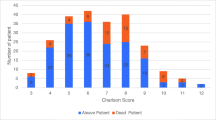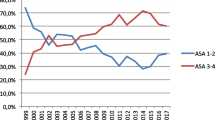Abstract
Summary
In the past 10 years after implementation, the orthogeriatric treatment model led in general to consistent outcomes for 1555 older adults in terms of most of the complications and mortality. Surgery was more often delayed to 24–48 h after arrival at the hospital, while the length of hospital stay shortened.
Introduction
Since 1 April 2008, patients aged ≥ 70 years presenting themselves with a hip fracture at Ziekenhuisgroep Twente (ZGT) have been treated according to the orthogeriatric treatment model. The aim of this study was to investigate if outcomes of the orthogeriatric treatment model are consistent over the first 10 years after implementation.
Methods
Between 1 April 2008 and 31 December 2016, patients aged ≥ 70 years who were surgically treated at ZGT for a hip fracture were included and divided into three periods equally distributed in time. Patient characteristics, in-hospital logistics, complications, and mortality data were compared between the three periods.
Results
A total of 1555 patients were included. There was a shift in the surgical treatment for the fractured neck of femur from dynamic hip screw/cannulated screws to hemiarthroplasty (p < 0.001). Surgery within 24 h after arrival to the hospital decreased (p < 0.001), while surgery within 48 h stayed the same (p = 0.085). Length of hospital stay significantly decreased over time (p < 0.001). Complication rates were consistent except for the number of postoperative anemia, delirium, and urinary tract infections. Mortality rates did not change over the years.
Conclusions
The orthogeriatric treatment model leads in general to consistent outcomes concerning mortality and most of the complications, except for postoperative anemia, delirium, and urinary tract infections. Inconsistent complication rates were influenced by altered diagnosis and treatment protocols. Length of hospital stay reduced, while time to surgery was more often delayed to 24–48 h. Monitoring clinical outcomes of the orthogeriatric treatment model over time is recommended in order to optimize and maintain the quality of care for this frail patient population.


Similar content being viewed by others
References
Cheng SY, Levy AR, Lefaivre KA, Guy P, Kuramoto L, Sobolev B (2011) Geographic trends in incidence of hip fractures: a comprehensive literature review. Osteoporos Int 22:2575–2586. https://doi.org/10.1007/s00198-011-1596-z
Forni S, Pieralli F, Sergi A, Lorini C, Bonaccorsi G, Vannucci A (2016) Mortality after hip fracture in the elderly: the role of a multidisciplinary approach and time to surgery in a retrospective observational study on 23,973 patients. Arch Gerontol Geriatr 66:13–17. https://doi.org/10.1016/j.archger.2016.04.014
Abrahamsen B, van Staa T, Ariely R, Olson M, Cooper C (2009) Excess mortality following hip fracture: a systematic epidemiological review. Osteoporos Int 20:1633–1650. https://doi.org/10.1007/s00198-009-0920-3
Jamal Sepah Y, Umer M, Khan A, Ullah Khan Niazi A (2010) Functional outcome, mortality and in-hospital complications of operative treatment in elderly patients with hip fractures in the developing world. Int Orthop 34:431–435. https://doi.org/10.1007/s00264-009-0803-4
Folbert ECE, Smit RS, van der Velde D, Regtuijt EMM, Klaren MH, Hegeman JHH (2012) Geriatric fracture center: a multidisciplinary treatment approach for older patients with a hip fracture improved quality of clinical care and short-term treatment outcomes. Geriatr Orthop Surg Rehabil 3:59–67. https://doi.org/10.1177/2151458512444288
Folbert EC, Hegeman JH, Vermeer M, Regtuijt EM, van der Velde D, ten Duis HJ, Slaets JP (2017) Improved 1-year mortality in elderly patients with a hip fracture following integrated orthogeriatric treatment. Osteoporos Int 28:269–277. https://doi.org/10.1007/s00198-016-3711-7
Auais M, Morin S, Nadeau L, Finch L, Mayo N (2013) Changes in frailty-related characteristics of the hip fracture population and their implications for healthcare services: evidence from Quebec, Canada. Osteoporos Int 24:2713–2724. https://doi.org/10.1007/s00198-013-2390-x
Leng S, Chen X, Mao G (2014) Frailty syndrome: an overview. Clin Interv Aging 9:433. https://doi.org/10.2147/CIA.S45300
Grigoryan KV, Javedan H, Rudolph JL (2014) Orthogeriatric care models and outcomes in hip fracture patients: a systematic review and meta-analysis. J Orthop Trauma 28:e49–e55. https://doi.org/10.1097/BOT.0b013e3182a5a045
Flikweert ER, Izaks GJ, Knobben BA et al (2014) The development of a comprehensive multidisciplinary care pathway for patients with a hip fracture: design and results of a clinical trial. BMC Musculoskelet Disord 15:188. https://doi.org/10.1186/1471-2474-15-188
Prestmo A, Hagen G, Sletvold O, Helbostad JL, Thingstad P, Taraldsen K, Lydersen S, Halsteinli V, Saltnes T, Lamb SE, Johnsen LG, Saltvedt I (2015) Comprehensive geriatric care for patients with hip fractures: a prospective, randomised, controlled trial. Lancet 385:1623–1633. https://doi.org/10.1016/S0140-6736(14)62409-0
Kammerlander C, Roth T, Friedman SM, Suhm N, Luger TJ, Kammerlander-Knauer U, Krappinger D, Blauth M (2010) Ortho-geriatric service—a literature review comparing different models. Osteoporos Int 21:637–646. https://doi.org/10.1007/s00198-010-1396-x
Kates SL (2016) Hip fracture programs: are they effective? Injury 47:S25–S27. https://doi.org/10.1016/S0020-1383(16)30006-7
Daabiss M (2011) American Society of Anaesthesiologists physical status classification. Indian J Anaesth 55:111–115. https://doi.org/10.4103/0019-5049.79879
Charlson ME, Pompei P, Ales KL, MacKenzie CR (1987) A new method of classifying prognostic comorbidity in longitudinal studies: development and validation. J Chronic Dis 40:373–383
Blanc B, Finch CA, Hallberg L et al (1968) Nutritional anaemias. Report of a WHO scientific group. World Health Organ Tech Rep Ser 405:1–40
Mahoney FI, Barthel DW (1965) Functional evaluation: the Barthel index. Md State Med J 14:61–65
Parker MJ, Palmer CR (1993) A new mobility score for predicting mortality after hip fracture. J Bone Joint Surg Br 75:797–798
Kristensen MT, Foss NB, Ekdahl C, Kehlet H (2010) Prefracture functional level evaluated by the new mobility score predicts in-hospital outcome after hip fracture surgery. Acta Orthop 81:296–302. https://doi.org/10.3109/17453674.2010.487240
Lau TW, Fang C, Leung F (2017) The effectiveness of a multidisciplinary hip fracture care model in improving the clinical outcome and the average cost of manpower. Osteoporos Int 28:791–798. https://doi.org/10.1007/s00198-016-3845-7
de Palma L, Torcianti M, Meco L, Catalani A, Marinelli M (2013) Operative delay and mortality in elderly patients with hip fracture: an observational study. Eur J Orthop Surg Traumatol 28:1–6. https://doi.org/10.1007/s00590-013-1241-y
Sciard D, Cattano D, Hussain M, Rosenstein A (2011) Perioperative management of proximal hip fractures in the elderly: the surgeon and the anesthesiologist. Minerva Anesthesiol 77:715–722
Baskaran D, Rahman S, Salmasi Y, Froghi S, Berber O, George M (2018) Effect of tranexamic acid use on blood loss and thromboembolic risk in hip fracture surgery: systematic review and meta-analysis. HIP Int 28:3–10. https://doi.org/10.5301/hipint.5000556
Hou G, Zhou F, Tian Y, Ji H, Zhang Z, Guo Y, Lv Y (2014) Predicting the need for blood transfusions in elderly patients with pertrochanteric femoral fractures. Injury 45:1932–1937. https://doi.org/10.1016/j.injury.2014.08.033
Adunsky A, Lichtenstein A, Mizrahi E et al (2003) Blood transfusion requirements in elderly hip fracture patients. Arch Gerontol Geriatr 36(1):75–81. https://doi.org/10.1016/S0167-4943(02)00059-6
Foss NB, Kehlet H (2006) Hidden blood loss after surgery for hip fracture. J Bone Joint Surg Br 88–B:1053–1059. https://doi.org/10.1302/0301-620X.88B8.17534
Kadar A, Chechik O, Steinberg E, Reider E, Sternheim A (2013) Predicting the need for blood transfusion in patients with hip fractures. Int Orthop 37:693–700. https://doi.org/10.1007/s00264-013-1795-7
Blandfort S, Gregersen M, Borris LC, Damsgaard EM (2017) Blood transfusion strategy and risk of postoperative delirium in nursing homes residents with hip fracture. A post hoc analysis based on the TRIFE randomized controlled trial. Aging Clin Exp Res 29:459–466. https://doi.org/10.1007/s40520-016-0587-5
Schuurmans MJ, Duursma SA, Shortridge-Baggett LM (2008) Early recognition of delirium: review of the literature. J Clin Nurs 10:721–729. https://doi.org/10.1111/j.1365-2702.2001.00548.x
Carpintero P, Caeiro JR, Carpintero R et al (2014) Complications of hip fractures: a review. World J Orthop. https://doi.org/10.5312/wjo.v5.i4.402
Bliemel C, Buecking B, Hack J, Aigner R, Eschbach DA, Ruchholtz S, Oberkircher L (2017) Urinary tract infection in patients with hip fracture: an underestimated event? Geriatr Gerontol Int 17:2369–2375. https://doi.org/10.1111/ggi.13077
Oh ES, Li M, Fafowora TM, Inouye SK, Chen CH, Rosman LM, Lyketsos CG, Sieber FE, Puhan MA (2015) Preoperative risk factors for postoperative delirium following hip fracture repair: a systematic review HHS public access. Int J Geriatr Psychiatry 30:900–910. https://doi.org/10.1002/gps.4233
Yassa R, Khalfaoui MY, Hujazi I et al (2017) Management of anticoagulation in hip fractures: a pragmatic approach. EFORT Open Rev 2:394–402. https://doi.org/10.1302/2058-5241.2.160083
American Academy of Orthopeadic Surgeons Guideline: Management of hip fractures in the elderly (2014) https://www.aaos.org/Reasearch/guidelines/HipFxGuideline_rev.pdf. Accessed 13 Oct 2018
Richtlijn proximale femurfracturen (2016) https://richtlijnendatabase.nl/richtlijn/prixmale_femurfracturen/proximale_femurfracturen_-_startpagina.html. Accessed 13 Oct 2018
Author information
Authors and Affiliations
Corresponding author
Ethics declarations
Conflicts of interest
None.
Electronic supplementary material
ESM 1
(DOCX 69 kb)
Rights and permissions
About this article
Cite this article
Nijmeijer, W.S., Folbert, E.C., Vermeer, M. et al. The consistency of care for older patients with a hip fracture: are the results of the integrated orthogeriatric treatment model of the Centre of Geriatric Traumatology consistent 10 years after implementation?. Arch Osteoporos 13, 131 (2018). https://doi.org/10.1007/s11657-018-0550-5
Received:
Accepted:
Published:
DOI: https://doi.org/10.1007/s11657-018-0550-5




